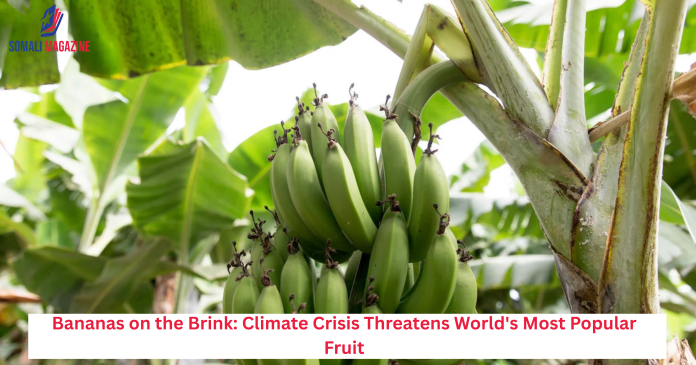Facebook Twitter (X) Instagram Somali Magazine - People's Magazine
Extreme weather and deadly plant diseases are destroying banana crops across Latin America, putting millions of livelihoods and global food security at risk.
Bananas, the most consumed fruit in the world, are now at serious risk because of the growing climate crisis. A new report by Christian Aid highlights how rising temperatures, droughts, floods, and climate-related plant diseases are badly affecting banana farms—especially in Latin America and the Caribbean, which produce about 80% of the world’s banana exports.
Without urgent action, the report warns, up to 60% of the land currently suitable for banana farming in the region could become unusable by 2080.
“Climate change has been killing our crops,” said Aurelia Pop Xo, a banana farmer in Guatemala. “My plantation has been dying. There is no income because we cannot sell anything. People said this would happen in the future, but it’s already happening.”
Bananas are the fourth most important food crop globally, after wheat, rice, and maize. More than 400 million people rely on bananas for as much as 27% of their daily calories. But despite this importance, the crop is becoming more fragile due to its heavy dependence on a single variety—the Cavendish banana.
The Cavendish banana is the one most people around the world eat. However, it’s a cloned variety, which means all the plants are genetically the same. While this makes them easier to grow and transport, it also makes them very vulnerable to disease. If one plant gets sick, all the others are at risk too.
One major threat is a disease called Fusarium Tropical Race 4 (TR4), a type of fungus that has already destroyed banana plantations in Asia and parts of Latin America. The fungus spreads more easily in the warmer, wetter conditions brought on by climate change. Another disease, known as Black Leaf Streak, thrives in hot and humid weather and can reduce banana harvests by up to 80%.
Countries like Guatemala, India, and Costa Rica are seeing clear drops in banana yields. This is creating serious problems for local farmers. Not only are they losing crops, but many are also being exposed to dangerous pesticides that are used to protect these large banana farms from pests and disease.
Christian Aid is urging rich countries to take responsibility by cutting their carbon emissions and providing financial support to farmers in vulnerable areas. The group also recommends more sustainable farming practices to protect banana crops. This includes:
-
Developing and planting banana varieties that can survive in droughts.
-
Improving irrigation systems to use water more efficiently.
-
Supporting fair trade farming that protects both the land and the workers.
“Banana growers are facing harder conditions every year due to climate change,” said Holly Woodward-Davey from Banana Link, a group focused on fair banana farming. “If we don’t change how bananas are grown and sold, we might lose the Cavendish banana entirely.”
Christian Aid’s climate campaigner Osai Ojigho added: “We need to take this seriously. Millions of people who depend on bananas for food and income are suffering—despite doing very little to cause climate change. We can’t ignore this any longer.”
The report serves as a wake-up call: without urgent action to tackle climate change and support more resilient farming methods, the future of the banana—and the people who rely on it—remains uncertain.

